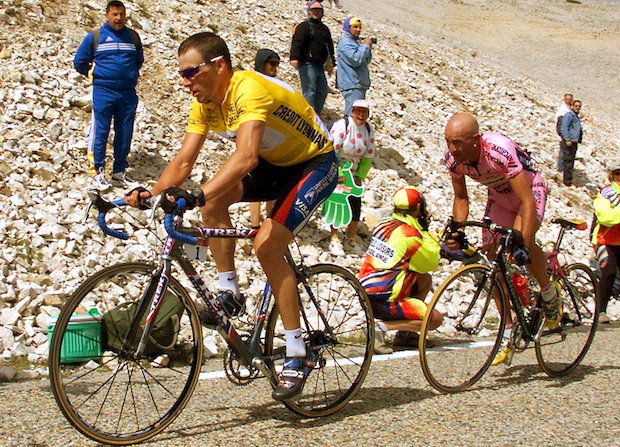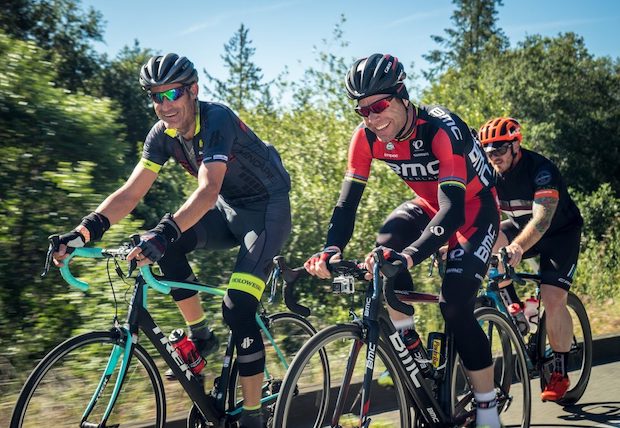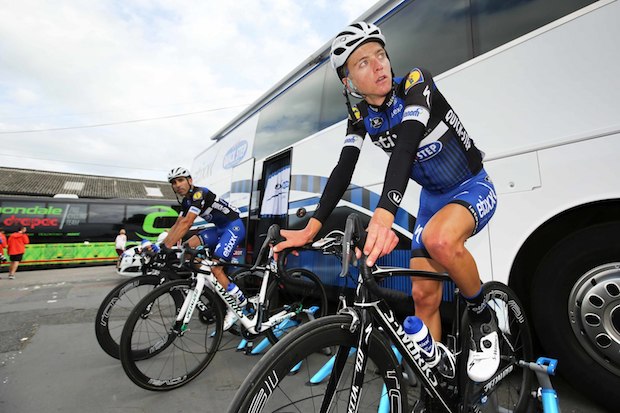Whether you’re racing against other riders or the clock, being a good hill climber is essential. Races are often won in the hills, and you can dramatically improve your climbing by doing the right training and improving your technique.
How to train for shorter climbs
a) Hill repeats
Find a hill that isn’t too steep and is split into three distinct phases. The ideal is one that starts reasonably steep, say 8-10%, and then in the middle third flattens slightly and then in the final third rears up to its steepest, say 10-12%. The length of the climb should be about two to three minutes.
Start with eight hill repeats and have a landmark at the bottom of the hill to start your computer and another at the top to stop your computer. Sprint at the start of the hill, sit down and change down on the flatter part, and then have an all-out sprint out of the saddle to the top.
Recover from the effort until you can breathe normally again and repeat. Try to get all eight repeats out at the same times. If you fade badly, stop the exercise, warm down and try again the next week. Record the times for each climb and make a note of the weather and wind direction, so you can compare sessions.
b) Change of pace
On longer hills that are reasonably steep, practise change of pace exercises. Start the hill at a moderate pace and then pick out a landmark about 250 metres ahead and sprint for it out of the saddle as hard as you can. Go back to a moderate pace and repeat as many times on each hill as the distance will allow.
If you can do this, it’s a wonderful way to crack the opposition in a race as the ‘stop go’ of the pace wrecks their rhythm and breaks their morale quicker than any other attack.
c) Brow sprints
How many times have you seen riders get to the top of a climb and stop pedalling to freewheel before they change into the big chainring? What a waste of time! Try practising brow sprints. This is where, on reaching the summit of the hill, you immediately get into your big ring and sprint over the brow into full speed for the descent.
This is a great place to attack in a race because you’ll notice that most riders will do this freewheeling lull after a tough climb, and you can create a gap really quickly. You can also be sure that others will hesitate to take up the chase and you can be away.
Even in time trials we’ve seen riders freewheeling over brows; that’s valuable seconds lost. Don’t hesitate – get into that big ring and sprint! You’ll have time to recover on the descent and can still be moving away from the others with the initial increase in momentum.
Technique tips for longer climbs
a) Sit down
Sitting in the saddle for as much of a long climb as possible is the most aerobically efficient way to the top. Sitting back in the saddle will recruit your glutes, giving the large muscles at the back of your thighs more leverage to pedal. Standing up on the pedals out of the saddle is more powerful but will use vital glycogen stores faster.
Even so, getting out of the saddle occasionally is essential to give your bum a rest, get circulation flowing again, and varying the muscle groups that are doing all the work. When you’re out of the saddle, try to resist rocking the bike too much, as exaggerated ‘honking’ is inefficient and can waste energy.
b) Relax
It’s a waste of energy and tiring to grip the bar tightly and consequently tense your upper body as you climb. Relax! Work on climbing with your back straight and shoulders back, with your hands resting on the bar tops. This will open up your diaphragm, making more space for your lungs to expand into and improve your aerobic efficiency.
Changing your hand positions on the bar will help avoid any pressure or repetitive strain injuries such as ulnar neuropathy. When standing on the pedals, it’s best to position the hands on the hoods for maximum stability.
c) Steady cadence
A steady cadence of about 90rpm is ideal. Don’t let a gear get too far ‘on top’ of you before you change into an easier one. This will sap your precious glycogen reserves, and changing down with too slow a crank speed puts a lot of pressure on mechanicals.
Just before you stand on the pedals, change up to a bigger gear to compensate for your lower cadence and to keep your power consistent. Change back into an easier gear when you sit down again.
If the gradient backs off or a tailwind gives you a helping hand, change up a gear to pick up your pace and keep your cadence and power output steady. If you consistently find yourself struggling or walking, fit easier gears.
d) Pace, don’t race
Pacing is crucial to deliver your best effort on a long climb. If you go too hard, too early, there’s a good chance you could blow before the top – and even if you don’t, going into oxygen debt and digging too deep into your muscle glycogen reserves may irreparably damage your whole ride performance.
The key is to stay aerobic as much as possible until you’re ready to give it your all – perhaps in the last few miles of the event’s summit finish. If you’re using a heart rate monitor, this threshold figure will typically be at about 65 percent of your maximum heart rate. If you’re riding on perceived exertion alone, you need to back off when holding a normal conversation is no longer possible.
e) Positioning in a group
Positioning on a climb is really important when you’re racing. If you aren’t a strong climber make sure you start every hill at the font of the group. You then have plenty of wheels to hold if you start to go backwards.
Always stay close to the rear wheel of the rider in front, but not directly on the wheel, this gives you an ‘escape route’ should he/she brake or ‘come back’ at you. Be aware of the wind direction and tuck into the lee side of the rider. Stay really close to the wheel and take as much shelter as you possibly can.
If there’s a lull on the climb, make an effort to move up again, preferably on the sheltered side of the bunch. Use your head and think about saving energy. If you’re a strong climber, try to split the bunch up by using the change of pace I have explained, or attack on the brow when they inevitably sit up!














